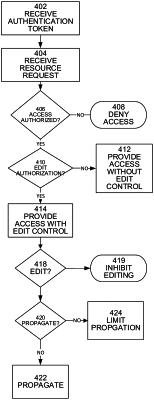| CPC H04L 63/1466 (2013.01) [G06F 16/94 (2019.01); H04L 63/0807 (2013.01); H04L 63/1416 (2013.01); H04L 63/20 (2013.01)] | 24 Claims |

|
1. A content management computer system comprising:
a computing device;
a network interface;
a non-transitory computer readable media configured to store instructions that when executed by the computing device, cause the computing device to perform operations comprising:
receive, via the network interface, an authentication token;
use the authentication token to determine associated access permissions for mesh-linked files, the mesh-linked files comprising files with forward links and backward links, the backward links comprising incoming links from other electronic resources, comprising at least one remote electronic resource, that link to a given file page of a given mesh-linked file, where two or more different pages in a given mesh-linked file are associated with respective different backlinks wherein at least one of the two or more different pages is associated with a plurality of backlinks;
identify, using the determined associated access permissions, permitted mesh-linked files;
use the authentication token to determine modification permissions associated with the permitted mesh-linked files, comprising at least one document with multiple backlinks;
enable, via the network interface, a user interface to be displayed, the user interface comprising entries corresponding to at least a portion of the permitted mesh-linked files, the entries corresponding to at least a portion of the permitted mesh-linked files organized in waterfall fashion;
based at least in part on a determination that a modification permission associated with the authentication token provides permission to modify the permitted mesh-linked files, enable a modification control to be enabled and presented via the user interface;
provide, via the user interface, a first set of links, comprising at least a search link, a statistics link, and a file galleries link, wherein activation of the statistics link causes statistics comprising how many times a given user shared a page in a given mesh-linked file with another user and/or an average or median time users have viewed a given page in a given mesh-linked file;
provide, via the user interface, a second set of links, comprising at least a compliance link, a tools link, and a local resources link;
provide, via the user interface, a second set of links to indexes, comprising at least a management controls index, an operational control index, and a technical controls index;
provide a backlink control, via the user interface;
at least partly in response to detecting activation of the backlink control, enabling a plurality of backlinks to be displayed, the backlinks corresponding to incoming links from network resources that link to a viewed page, wherein activation of a backlink cause a corresponding network resource to be accessed over a network and rendered;
at least partly in response to activation of the modification control, enable a modification field to be presented via the user interface, the modification field configured to receive user modifications with respect to one or more items of content of the user interface;
provide a user interface that enables a propagation rule to be specified and received by the user interface, wherein the user interface enables a specification as to whom modifications are to be propagated to;
at least partly in response to receipt of a save or publish instruction, enable the modified content to be propagated in accordance with at least a first propagation rule, to one or more destinations; and
based on frequency of access, positioning a first set of links at a first location via the user interface.
|